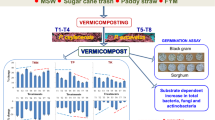Abstract
The composting potential of two epigeic earthworms (P. excavatus and P. sansibaricus) was studied in 2002 to breakdown the domestic waste under laboratory conditions. The experimental container with P. sansibaricus showed maximum mineralization and decomposition rate than that of P. excavatus. Except for exchangeable K (it was higher (P = 0.004) in a container with P. excavatus), the domestic waste processed by P. sansibaricus showed about 6% more total nitrogen (P = 0.002) and about 7% more available P (P = 0.269) at the end than by P. excavatus. As compared with the initial level organic C content as well as C:N ratio showed a considerable reduction that was noted higher in substrate with P. sansibaricus than those by P. excavatus (organic C, t-test: P = 0.870; C:N ratio, t-test: P = 0.002). The growth (biomass increase) and reproduction parameters such as mean individual live weight, maximum individual growth rate (mg wt./worm/day), number of cocoons and reproduction rate (cocoon/worm/day) were higher in bedding with P. sansibaricus. The maximum earthworm mortality was in vermibed having P. sansibaricus (∼50% higher than by P. excavatus) (t-test: P = 0.423), since both species did not show a drastic difference in waste mineralization rate, but comparatively, P. excavatus exhibited better growth and reproduction performance, which further support the suitability of the species for large scale vermiculture operations.
Similar content being viewed by others
References
Anderson, J. M.; Ingram, J. S. I., (1993). Soil organic matter and organic carbon. In: Anderson, J. M. Ingram, J. S. I. (Eds), Tropical soil biology and fertility: A hand book of mwthods, Wallingford, UK, CAB Internationals.
Benitez, E.; Nogales, R.; Elvira, C.; Masciandaro, G.; Ceccanti, B., (1999). Enzyme activities as indicators of the stabilization of sewage sludges composting with Eisenia foetida. Bioresource Tech., 67, 297–303.
Butt, K. R., (1993). Utilization of solid paper mill sludge and spent brewery yeast as a food for soil-dwelling earthworms. Bioresource Tech., 44, 105–107.
Delgado, M.; Bigeriego, M.; Walter, I.; Calbo, R., (1995). Use of California red worm in sewage sludge transformation. Turrialba, 45, 33–41.
Dominguez, J.; Edwards, C. A.; Ashby, J., (2001). The biology and population dynamics of Eudrilus eugeniae (Kinberg) (Oligochaeta) in cattle waste solids. Pedobiologia., 45, 341–353.
Edwards, C. A.; Dominguez, J.; Neuhauser, E. F., (1998). Growth and reproduction of Perionyx excavatus (Perr.) (Megascolecidae) as factors in organic waste management. Biol. Fert. Soils, 27, 155–161.
Elvira, C.; Sampedro, L.; Benitez, E.; Nogales, R., (1998). Vermicomposting of sludges from paper mill and dairy industries with Eisenia andrei: A pilot scale study. Bioresource Tech., 63, 205–211
Garg, P.; Gupta, A.; Satya, S., (2006). Vermicomposting of different types of waste using Eisenia foetida: A comparative study. Bioresource Tech., 97, 391–395.
Garg, V. K.; Kaushik, P., (2005). Vermistabilization of textile mill sludge spiked with poultry droppings by epigeic earthworm Eisenia fetida. Bioresource Tech., 96, 1063–1071.
Haimi, J.; Huhta, V., (1986). Capacity of various organic residues to support adequate earthworm biomass for vermicomposting. Biol. Fert. Soils, 2, 23–27.
Jackson, M. L., (1973). Soil chemical analysis. Pranctice Hall of India, New Delhi.
Kale, R. D.; Bano, K.; Krishnamoorthy, R. V., (1982). Potential of Perionyx excavatus for utilizing organic wastes. Pedobiologia, 23, 419–425.
Le Bayon, R. C.; Binet, F., (2006). Earthworm changes the distribution and availability of phosphorous in organic substrates. Soil Biol. Biochem., 38, 235–246.
Lee, K. E., (1992). Some trends opportunities in earthworm research or: Darwin’s children. The future of our discipline. Soil Biol. Biochem., 24, 1765–1771.
Manna, M. C.; Jha, S.; Ghosh, P. K.; Acharya, C. L., (2003). Comparative efficiency of three epigeic earthworms under different deciduous forest litters decomposition. Bioresource Tech., 88(3), 197–206.
Ndegwa, P. M.; Thompson, S. A.; Das, K. C., (2000). Effects of stocking density and feeding rate on vermicomposting of biosolids. Bioresource Tech., 71, 5–12.
Neuhauser, E. F.; Loehr, R. C.; Makecki, M. R., (1988). The potential of earthworms for managing sewage sludge. In: Edwards, C. A., Neuhauser, E. F. (Eds), Earthworm in waste and environmental management. SPB Academic Publishing, The Hugue, 9–20.
Reinecke, A. J.; Viljoen, S. A.; Saayman, R. J., (1992). The suitability of Eudrilus eugeniae, Perionyx excavatus and Eisenia fetida (Oligochaeta) for vermicomposting in southern Africa in terms of their temperature requirements. Soil Biol. Biochem., 24(12), 1295–1307.
Simard, R. R., (1993). Ammonium acetate extractable elements. In: Martin, R., Carter, S., (Eds), Soil sampling and methods of analysis. Lewis Publisher, Florida, USA. 39–43.
Suthar, S., (2006). Potential utilization of guargum industrial waste in vermicompost production. Bioresource Tech., 97, 2474–2477.
Suthar, S., (2007a). Vermicomposting potential of Perionyx sansibaricus (Perrier) in different waste materials. Bioresource Tech., 98, 1231–1237.
Suthar, S., (2007b). Nutrient changes and biodynamics of epigeic earthworm Perionyx excavatus (Perrier) during recycling of some agriculture wastes. Bioresource Tech., 98, 1608–1614.
Suthar, S., (2007c). Production of vermifertilizer from guar gum industrial waste by using composting earthworm Perionyx sansibaricus (Perrier). Environmentalist, 27,(1), 329–335.
Walkley, A.; Black, I. A., (1934). An examination of the Degtjareff method for determining soil organic matter and prepared modification of the chronic acid titration method. Soil Sci., 34, 29–38.
Author information
Authors and Affiliations
Corresponding author
Rights and permissions
About this article
Cite this article
Suthar, S., Singh, S. Vermicomposting of domestic waste by using two epigeic earthworms (Perionyx excavatus and Perionyx sansibaricus). Int. J. Environ. Sci. Technol. 5, 99–106 (2008). https://doi.org/10.1007/BF03326002
Received:
Revised:
Accepted:
Published:
Issue Date:
DOI: https://doi.org/10.1007/BF03326002




